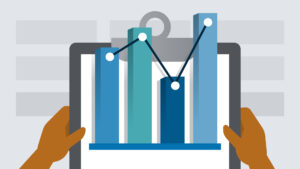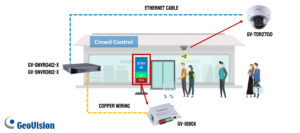![]()
Social distancing, also called physical distancing, has emerged as a new public standard to help prevent the spread of COVID-19. Enforcing these new rules, though, is a challenge. Crowd detection analytics could help.
Limiting occupancy, crowding
Crowd detection analytics can be used to limit occupancy and detect overcrowding in any environment. Since there is no exception for social distancing, the use of crowd detection could be a vital tool to help ensure that physical distancing is observed in all settings.
Crowd analytics are most useful when deployed across the entire area, with particular focus on choke points where people typically queue or gather.
Analytics — and the alerts that are triggered if a threshold is breached — can help the venue to predict or identify issues like crowding, pinch-points or queues that risk breaching social distancing guidelines.
It is recommended to deploy aggregated counting analytics at entrances and exits to help enforce social distancing guidelines. While this approach doesn’t directly address the physical separating between individuals, it can be very helpful to ensure building or room occupancy limits are followed.
Changing the flow of traffic

Not only can crowd analytics be used to restrict the number of people in an area, but it can also be used to dynamically change routes and the flow of traffic to maintain social distancing.
To avoid close contact and congestion in shops and grocery stores, store managers can use one-way detection based on video analytics to warn customers and alert store managers if someone is going in the wrong direction.
Doing this can also provide store managers with valuable information and statistics about the effectiveness of the implementation of routes they have chosen for their shop.
Taking action to social distance

Social distancing and related regulations may vary in different regions and different environments. For this reason, since venue owners know their spaces best, crowd detection use cases will differ. Hence, each venue should be in control of setting their own thresholds.
Different actions that venues might take include using alerts in a transport scenario to trigger a station or platform closure making sure that passengers and staff maintain social distancing, or to reduce overcrowding on a bus or carriage by alerting the driver that they have reached capacity.
Alternatively, venues may be able to make the visual dashboard available to citizens via a digital display screen in shopping malls or via an app that users can log into. Doing so would allow citizens to make their own decisions about whether to enter an area or the route to navigate.
Aside from crowd detection analytics and alerts, some solutions further offer venues an audit trail and a history log of the level of footfall density. With this information, venues can make operational decisions about urban spatial planning.
If necessary, the reports can be used to show authorities the level of social distancing being achieved in an area, and to prove that the venue is taking responsible steps.
The importance of this information can help release venues from lockdowns, which would require a high degree of confidence from the people most affected (e.g., front-line staff such as teachers, waitresses, shop workers, etc.). Putting crowd detection tools in place provides evidence to these important stakeholders that the venue is doing what it can to protect people.
What are the concerns and solutions to deploy crowd detection in public spaces?

Responsibly and reliably deploying a crowd detection system in public spaces is of paramount importance. You can’t have one without the other. Yet, many of the main concerns surrounding crowd counting have something to do with one or both of these ideas.
Accuracy, processing power and flexibility
Obviously, accuracy is required to deploy a successful crowd detection solution. Without it, there is no point in deploying one.
While advancements in algorithms — thanks to deep learning and other techniques — are helping on the accuracy and reliability front, one of the biggest concern when deploying crowd detection analytics is processing power and the suitability of the analytics in the environment where you want to deploy.
To meet processing power requirements, GPU support on the server can be used but the better approach is to use an embedded platform with pre-trained and customized datasets.
Crowd analytic tools must also be flexible enough to allow end users to set limits for any environment, at the levels they think are necessary for their space.
Privacy protection
As with any analytic used in a public domain, privacy is a major concern. The use of face recognition software by government organizations has already been banned in several places in the U.S. Earlier this year the European Commission had also considered banning the use of face recognition in public areas for up to five years — it later backtracked on this.
Today, The COVID-19 pandemic is accelerating the use of digital technologies across work life, in the home and in our social interactions. This creates new opportunities but also risks and challenges on a global scale. Innovations in technology should be celebrated, but we must acknowledge our role in developing new technologies responsibly.
Since the very nature of crowd detection is to identify the number of people in a space, there are obvious concerns about personal and data privacy. It is highly important to provide accurate real-time data whilst ensuring that the persons who are “in view” cannot be individually identified.
For example, a solution can detect people in public spaces using either cameras that act as sensors, which are mounted directly overhead so that faces or individual attributes cannot be seen, or by deploying LiDAR sensors, which detect the human form rather than any personalized characteristics.
As another example, a solution can give the venue control of setting their own thresholds by using anonymous data gathered from Wi-Fi networks, and to alert them and give them insight to take proactive steps to manage a crowd.
They can publish this information or show it on a digital screen to show the public and allow people to take their own preventative steps. This anonymous approach protects individual privacy and gives the venue the information it needs to manage crowding.
Safer crowds
Crowd analytics will only continue to advance as deep learning algorithms get smarter and analytics providers continue to innovate, and it couldn’t come at a better time. While we all watch and wait to see how the pandemic plays out and see what the lasting effects are on the way we interact with each other, use cases for crowd detection will grow.
Adapted from a&s Magazine



































































